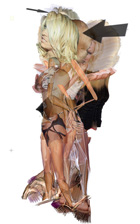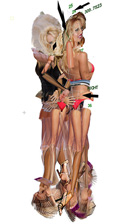



The Virtual Public Art Project is a whole new kind of art. One where all the art is virtual in a 2 D perspective, yet presented in a 3D reality. This project spans over five continents with twenty eight locations in places like Philadelphia, Tokyo, Beijing and London. VPAP leads the public to a location such as an open field and even a city scape and with the use of smart phone technology presents a virtual sculpture on the landscape which the viewer can span practically 360*. Anyone with an iPhone 3GS or Andriod can download the app: Layer, and start the Augmented Reality art process needed to experience VPAP.
After the Layar app is installed on your phone you can search for sites and then once you are close to a VPAP site you can switch to Map view. This will direct you to the specific location of the virtual sculpture. Then you have to switch to reality view and the virtual sculpture will pop up on your phones screen and you can walk around the area and see it from multiple views. So in the end you are seeing the natural landscape along with the virtual sculpture. It is a huge contrast and a new art revolution. Many if not all of these virtual sculptures are never actually constructed into 3D models. This art style reminds me a lot of the hologram figures seen in movies such as Star wars. Where the actors would appear 3D, and walk around and gesture while talking yet you could still see through them and see the landscape of the room around them.
Three of the artists mentioned on rhizome that have created sculptures for VPAP are Alvaro Barata, Christian Meinhardt, and Christopher Manzione. Barata creates drawings use a technique called anamorphosis. This is when the drawing viewed from a different perspective reveals a different image creating a 3D effect. Meinhardt created the Mirrored City in France. This was ten blocked sections of Laval simplified to the core elements of the city, hovering over the real city. Manzione also has work in the U.S. called Symmetry and Growth.
This is more than just art, VPAP is an art revolution. It is transforming the world of sculpture as we know it. A Sculpture no longer solely describes a 3D crafted, touchable, piece of work but it now can describe something in 2D viewed on a screen in a virtual plane. Also, since the artists have chosen to place their virtual masterpieces in places you must visit to see it gives it more of a realistic aspect. You can’t just watch a video online to see around the sculpture. You must physically go to the location and walk around in a circle to view the whole sculpture. It is fascinating just to think what might come next.
Our world is beginning to revolve completely around technology. Everything we touch and do has had some computer and technological effect on it. Art used to be only what you could touch and see not it is also what can be viewed on a computer screen and phone. I think the only was the artists around the world could improve this concept is to expand. Expand, expand expand. Publicize it more, put the idea out more so the general public will know about this whole art revolution also. I had never even heard about it until this research. But now through learning about it I want to go to one of the sites and look at the sculptures.


Andreas Muller-Pohle was born in Brunswick, Germany he is an artist and publisher. He has been the editor of European Photography magazine since 1980. He has been a consultant and a visiting professor for many institutions.(biography) Pohle has written books , participated in photo festivals, has been in many exhibitions featureing his photography and digital works and participates in the Danube River Project. His current project is Hong Kong Waters, a multimedia water trilogy.
I researched Andreas Muller-Pohle because I thought his work was interesting due to the fact that he is a photographer much like myself. On his website his photographs are described as a result of “theoretical reflection”. Most of his work is based off of photography. And then he relates them to the digital world. Pohle believes that the camera is a program that is meant to see the outside world as the photographer/viewer sees it. This means that the viewers’ interests are projected onto the photo itself. Pohle’s alternate concept of photography is to follow these steps “(1) take hold of the camera; (2) press upon the releaser; (3) look at the pictures that result; (4) choose one”. The decisions then go from you choosing what to photograph, to choosing an already made photograph. Then you will see that the camera alone can create elegant and abstract images. His collection of images using this technique is called Transformance. Much like digital art in these pictures you may not be able to tell what something is because it is from a different perception.

Through his work I see an alternate universe, when in reality it is everyday landscapes and objects just altered through digital art and other techniques. The perception of the world he creates is compelling and striking. Whether he has altered a mountain landscape into a dream like illusion, or taken photos without ever looking to create a “space-time-continuum” or even decoding the alphanumeric code of faces, he has created meaningful art if its own kind. More specifically in the reading his digitized images were shown. He took a photo and converted the bytes into alphanumberic code in eight panels. Then he also did a series called face codes where he took videos and then took the still images like photos of people and reworked them digitally to show a alphanumeric code and then showed that code on the bottom of the screen. Also, he took the worlds first photograph and through digital encoding created an image.

His work has its own style so, therefore I do not believe he could do anything differently to make it better. But I think he could have expanded on his Constellations and Transformance collections to incorporate more unique things then the side of a building or water.